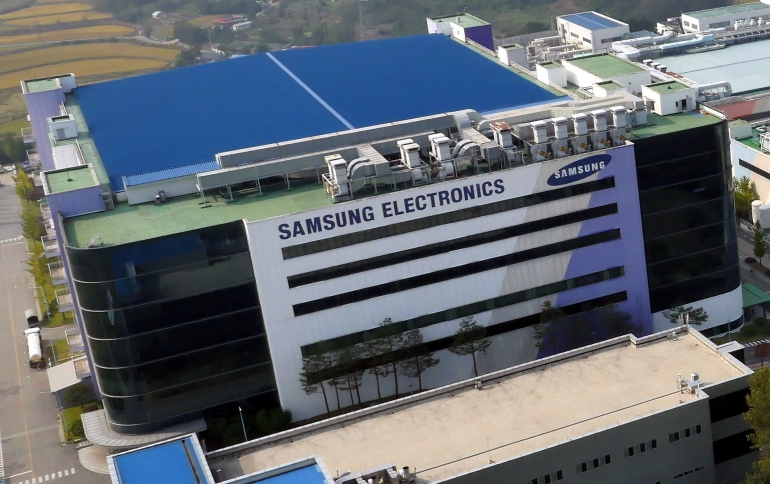
Samsung Announces Record Q3 Operating Profit, Signals Caution in Semiconductors
Samsung Electronics posted record quarterly profit on growth in its memory chip business, but signaled caution in semiconductors by announcing a cut in capital spending for the year.
The company posted KRW 65.46 trillion in consolidated quarterly revenue, up 5.5 percent from a year earlier, and KRW 17.57 trillion in quarterly operating profit, up 20.9 percent.
Samsung said that its high operating profit was driven mainly by the continued strength of its Memory Business. Total revenue increased YoY and QoQ on the back of strong sales of memory products and OLED panels.
By business unit, Samsung's Semiconductor Business recorded higher earnings YoY and QoQ amid strong seasonal demand, particularly for server and mobile memory. While NAND and DRAM demand remained high, the Memory Business improved its earnings by concentrating on sales of premium products, improving yields, and ramping up production of high-density chips at its Pyeongtaek plant.
For the Display Panel Business, despite unfavorable supply-demand conditions in the LCD market, Q3 earnings improved on-year thanks to higher sales of flexible OLED panels to major customers. On a quarterly basis, earnings significantly grew due to increased utilization of flexible OLED panel capacity.
Amid intense market competition, the IT & Mobile Communications (IM) Division reported a drop in Q3 earnings despite solid sales of its flagship smartphones. Overall, its smartphone shipments remained flat due to a decrease in sales of mid- to low-end products. Profit was also down due to increased promotional costs and a negative currency impact.
For the Consumer Electronics (CE) Division, Q3 earnings improved both YoY and QoQ thanks to robust sales of premium TV products, such as QLED and ultra-large screen TVs of 75-inches and above.
For the System LSI Business, overall Q3 earnings improved thanks to the demand for image sensors in China and for OLED DDIs used in flagship smartphones. In particular, the image sensor business achieved record-high quarterly results driven by greater adoption of multiple cameras and high-resolution sensors by smartphone makers.
For the Foundry Business, Q3 earnings continued to grow QoQ thanks to increased demand for mobile APs and image sensors, despite a decline in demand for cryptocurrency mining chips. In particular, Samsung secured technological leadership in advanced processes by completing development and starting production of the EUV-based 7-nanometer process.
Outlook
Looking ahead to the fourth quarter, Samsung expects overall earnings across the company to decline as it enters a period of weak seasonality for the semiconductor market.
For the components businesses, Samsung expects earnings from memory chips to decline on weaker seasonality, but will remain strong for OLED panels thanks to continued high demand.
Although shipments of smartphones are forecast to rise, Samsung said that increased marketing expenses during the year-end peak season will affect profitability. Meanwhile, the company's Networks Business will look to cement its position at the forefront of 5G technology as it begins supplying 5G equipment; shipping to customers in North America and Korea in the fourth quarter.
Samsung plans to strengthen its market leadership by focusing on the premium market for All-Flash-Array solutions and high-density UFS. Looking ahead to 2019. Samsung will focus on enhancing cost competitiveness through expansion of 5th-generation V-NAND.
The South Korean company expects its CE Division tobenefit from strong year-end seasonality in the fourth quarter. Samsung expects earnings to rise on the back of higher consumer demand for QLED TVs and premium home appliances.
For the System LSI Business, overall Q3 earnings improved thanks to the demand for image sensors in China and for OLED DDIs used in flagship smartphones. In particular, the image sensor business achieved record-high quarterly results driven by greater adoption of multiple cameras and high-resolution sensors by smartphone makers.
For 2019, Samsung expects solid earnings growth to continue, bolstered by rising demand for image sensors used in more sophisticated camera specifications. Additionally, Samsung plans to diversify its customer base in China and the U.S. by enhancing SoC competitiveness using 5G modem technology. The Company will also focus on diversifying its product line-up to include 3D sensors, fingerprint-on-display sensors, and chips used in automotive and IoT applications.
Looking to the fourth quarter, Samsung expects the demand for mobile APs and image sensors to decline amid weak seasonality for smartphone components.
In 2019, Samsung will focus on achieving solid results by ensuring a stable supply of major products—such as mobile APs and image sensors—and diversifying its customer bases in AI, automotive, and 8-inch areas. Additionally, the company will strive to maintain its technology leadership through full-scale mass production of the 7-nanometer EUV process, and plans to expand its customer base by more than 30 percent.
In 2019, Samsung's OLED business will look to expand into new product categories by continuing to offer technologically differentiated products and to broaden the customer base with flexible panels. The company will also aim to further its leadership by enhancing the technical readiness of new applications for foldable, automotive and IT displays. Additionally, the OLED business will seek to reinforce partnerships with major smartphone manufacturers.





















